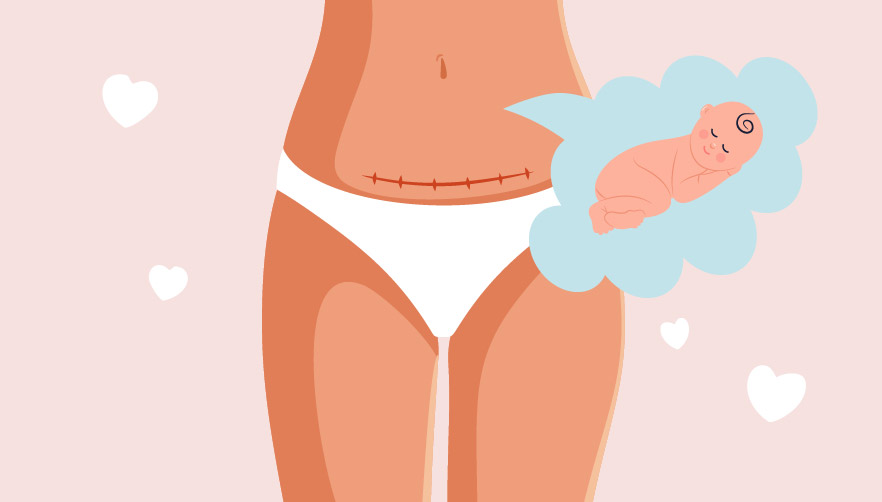How Caesareans Really Impact You and Your Baby’s Health

A cesarean section, commonly referred to as a c-section or ‘caesarean,’ is a surgical procedure where the doctor makes an incision in the mother’s abdominal and uterus walls and delivers the baby through the incision.
According to the WHO, global C-section rates have increased significantly from 7% in 1990 to 21% today. There are many factors for this rise, from more availability of life-saving health procedures to a rise in women electing to have the procedure due to age.
Despite how common this procedure is, there are still many misconceptions surrounding c-sections, their potential complications, whether they preserve pelvic floor health better than vaginal birth, and how they may affect your infant.
Why You (Or Your Doctor) May Choose a C-Section
If there are problems preventing the baby from being born through normal vaginal birth, your doctor may be forced to perform a c-section. Your doctor may also discuss an elective (planned) c-section if there is the potential that vaginal birth is risky.
While there is the possibility of electing for a c-section even if you don’t face complications, most doctors concur that vaginal birth (when possible) is the safest way to deliver a child. You, your partner, and your obstetrician should discuss your options and choose the best one for you.
Why You and Your Doctor May Plan a C-Section
Not all women may be required to have c-sections even if they fall under these circumstances, but common reasons for planned c-sections include:
- You’ve previously had a c-section
- Your baby is in the breech position (bottom or feet first rather than head first) and cannot be turned
- Your baby is transverse (lying sideways) and unable to be turned
- The placenta is blocking your cervix
- You’re birthing twins and the first baby is in a breech position
- You’re having three or more babies
Why Your Doctor May Perform an Unplanned C-Section
- Your contractions aren’t strong enough and your labor is not progressing
- Your cervix is opening too slowly or not at all
- Your baby’s head is not moving downwards or fitting through your pelvis
- The umbilical cord has prolapsed through the cervix and into the vagina after your waters have broken
- Your baby exhibits signs that their health is being compromised
- A health problem that makes labor riskier for you and your baby such as high blood pressure
Potential Risks of A C-Section To The Mother
In most countries with modern medical care, a c-section is a relatively safe surgical procedure that is performed all the time, but as with all major surgical procedures, it carries certain risks for both you and the baby. Some common risks and complications during the procedure include:
- Blood clots in the legs
- Above-average blood loss
- An extended stay in the hospital
- The uterine lining becoming infected
- Issues with being able to give vaginal birth in the future
- Pain around the incision
- Anaesthetic-related complications
The Tightness Myth
There is a common misconception that delivering a baby via c-section will help retain vaginal tightness more than vaginal birth.
While there is evidence suggesting that birthing via c-section has lower risks of pelvic organ prolapse and urinary incontinence than vaginal birth, vaginal tightness depends on pelvic floor health, and c-sections still impact pelvic floor muscles and overall lower-body health. For example, women who have c-sections are more likely to experience pain during sex, as well as in their genitals, lower abdomen, and urinary tract.
Our bodies are going to be different postpartum no matter what you do. Even though the baby doesn’t pass through the vaginal canal during a c-section, the pelvic floor muscles, vulva, and vagina are still stressed.
Caesareans are a significant surgery that often impacts pelvic floor and core coordination and strength. This means that you may still develop postpartum pelvic floor dysfunction even if you don’t give vaginal birth.
You may have a higher risk of developing postpartum pelvic floor dysfunction if:
- You have pre-existing pelvic floor dysfunction
- You’re having the baby at an older age
- Your BMI is higher than recommended at delivery
- You’re delivering a larger baby
- You have a family history of pelvic floor problems
Some Childhood Conditions May Be Correlated To C-Sections
It’s important to note that the potential risks to your baby during a C-section are actually far less than during vaginal birth. However, there are some studies showing positive correlations between certain health conditions and babies delivered via c-section.
One of those is breathing issues, especially if the c-section is performed before 39 weeks, because the process of labor helps clear the baby’s lungs of fluid. There appears to be a correlation between being born through c-section and the baby developing asthma later in life.
Other health conditions that may be potentially correlated with c-section delivery include:
- Asthma
- Allergic rhinitis or conjunctivitis
- Atopic dermatitis or eczema
- Food allergies
- Allergic sensitization in offspring
Again, whether or not you elect for a c-section or vaginal birth depends on your health and personal preferences. Your obstetrician should explain each aspect of delivery to you and guide you to make informed decisions about your health.

Clara Wang is a freelance writer based in Nashville, TN but often found abroad. She mostly muses about the three best things in life: Food, sex, and music. Her work has been featured in publications such as Eater Austin, Eater Nashville, Giddy, Buzzfeed, Refinery29, the Austin Chronicle, the Austin American Statesman, and the Daily Dot.


